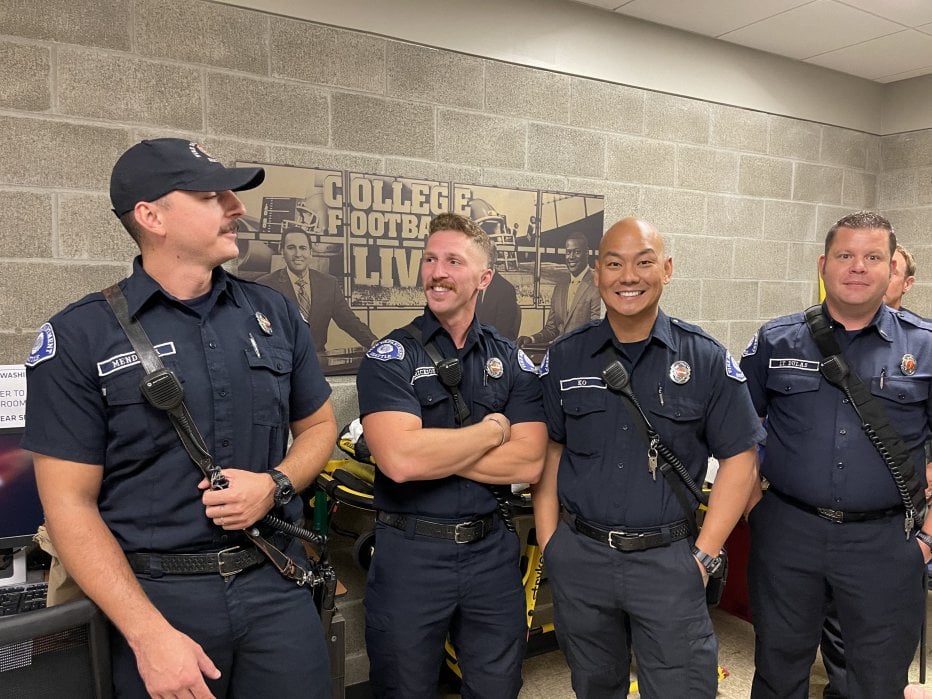The Benefits of Annual Medical Physicals for Firefighters

By: Gary L Krichbaum, MA, NRP. CFO Program Manager for First Responder Center for Excellence
The father of the American fire service Benjamin Franklin is credited with famously stating that “An ounce of prevention is worth a pound of cure.” Although coined in the 1700s and was directed towards fire prevention, this adage is more relevant than it has ever been in several areas of the fire service today.
Advances in technology combined with sound research have provided American firefighters with more advantages in avoiding or treating occupational illnesses than at any time in our history. As the environment in which we operate continues to change at a rapid rate, we must keep pace in ensuring that we are instilling the safest practices available and become proactive in ensuring our optimal health.
The National Center for Chronic Disease Prevention and Health Promotion (NCCDPHP) reports that chronic diseases such as heart disease and cancer are the leading causes of death and disability in the United States. This correlation falls in line with the fire service as the National Fallen Firefighters Foundation (NFFF) continues to list these illnesses as the major causes of line-of-duty deaths (LODDs) year after year. Additionally, according to a research article published in the American Action Forum (AAF), the costs associated with chronic disease in the United States— both direct and indirect — amount to an average of $37 trillion per year, about 19.6% of the US gross domestic product. This is a similar burden for departments across the nation that are dealing with the consequences of illnesses through workforce reductions, time lost, and associated costs. Fortunately for the modern-day firefighter, we are gifted with science-based interventions to prevent these illnesses from developing and better management of existing chronic diseases, thus improving our ability to provide services and firefighters’ quality of life.
As we continue to better understand chronic disease, its management, and potential risk factors, many organizations and departments are advocating for campaigns to reduce disease risk. These movements include safer fire ground practices, food and exercise education, and promoting annual medical evaluations. Regardless of your age, position, current health condition, or stage of life, annual physical exams are essential to your ongoing health. Yearly physicals should include medical tests and lab screenings designed to gauge your overall health and test for evidence of chronic diseases and other occupational health conditions that may affect you in the future. As this should resonate with every firefighter, and their family/friends, a 2021 NFPA report revealed that most departments (61 percent) do not provide medical and physical evaluations that comply with NFPA 1582, Standard on Comprehensive Occupational Medical Program for Fire Departments. This deficiency may be more prevalent in our smaller rural departments, but cases of larger departments opting to not provide this benefit to their members have slowly emerged. The importance of early detection cannot be overstated and can significantly enhance the quality and length of life through early intervention. As we all know, knowledge is power, and the sooner you have the information, the better.
Benefits of Annual Medical Evaluations
Regardless of whether your department provides a regular medical exam, visiting your Primary Care Provider (PCP) annually is strongly encouraged. Remember that NFPA-compliant physicals are evaluating your ability to perform firefighter job functions and are not a substitute for seeing a PCP each year to establish a holistic representation of your overall wellness. Further benefits of receiving annual medical evaluations are:
- Establishing a personal health baseline
One of the more important benefits of having regular medical physicals is the understanding of your current health and potential risk factors for disease. An annual exam helps your doctor determine what is typical for you and develop a baseline. Knowing how your body functions on a normal day will provide your physician with a model for detecting any abnormalities and may enable early detection of chronic disease. Knowing what normal looks like is the first step to recognizing abnormal.
- Stay updated on important preventive screenings
When it comes to protecting and preserving your long-term health, there’s only one thing you need to remember: An annual physical allows your doctor to spot early disease symptoms that have the potential to progress and become bigger issues down the line. Documents such as the First Responder Center for Excellence (FRCE) Provider’s Guide for Firefighter Annual Evaluations and the Provider’s Guide to FEMALE FIREFIGHTER MEDICAL EVALUATIONS, with OB/GYN recommendations, can help PCPs better understand the physiological demands of firefighting and the associated risk factors that evidence-based research shows firefighters are most prone to.
- Prevent Avoidable Chronic Conditions and Diseases
Most firefighters have a sense of invincibility regarding their health and well-being. This is basic human nature if you have never had a serious illness, especially if you are part of a younger and healthier generation of firefighters. However, changes in health can slowly develop because of stress, unhealthy lifestyles, genetics, or the natural effects of aging. Health conditions can change quickly, with little or no warning, if not recognized and treated early. For example, an estimated 116 million Americans suffer from high blood pressure, but only approximately 1 out of every 3 people do not know they have it. Working with your PCP will greatly increase the chances of managing and/or avoiding many chronic diseases and illnesses.
- Early Interventions
Firefighters operate in extremely hazardous conditions which require us to be increasingly susceptible to occupational illnesses. Unfortunately, this has been and will continue to be a health-damaging part of the job which will generate acute and chronic medical conditions that may be unavoidable. Early intervention with effective treatments is most effective during the early stages of an illness and increases the odds of being cured. Interventions can be classified into two broad categories: (1) preventive interventions that prevent the disease from occurring and (2) therapeutic interventions that treat, mitigate, or postpone the effects of the disease to reduce the morbidity, disability, or fatality associated with a disease. The importance of early diagnosis and early treatment is tremendously valuable for many of the diseases that are inflicting firefighters.
NFPA 1582 Exam
The National Fire Protection Association (NFPA) developed NFPA 1582, a standard that was designed to establish minimum requirements for comprehensive occupational medical evaluation programs to assure fire departments that their firefighters are healthy, fit, and able to perform his/her duties safely. The standard also provides guidance on identifying medical conditions that may impair a firefighter’s ability to perform their duties or require additional medical evaluations. Although designed to establish standards that could be used by a department, the benefit of receiving a comprehensive physical examination is extremely beneficial to the firefighter.
It is encouraging to see that some departments provide this physical examination to both paid and volunteer firefighters with many requiring annual physicals to be operationally functional. However, this comprehensive battery of tests is often expensive and is the responsibility of the firefighter’s department, agency, or company. This exorbitant cost is often the cited reason for fire departments to waive a requirement for a yearly physical examination. Regardless, if you are fortunate enough to receive a NFPA 1582 exam, or if your department offers a variation of a yearly physical, it DOES NOT replace an annual visit to your PCP for all the reasons listed above.
Get Your Physical
In recent decades the emphasis on illnesses and injuries has shifted from acute care, or just the treatment of an illness, to focusing more on prevention. Often, we take our health for granted and avoid annual exams and screenings because we do not feel ill, or we are hesitant to know the truth about our health. The FRCE has a tagline for promoting annual firefighter physicals – “You can’t save others if you don’t save yourself”. Firefighters are in the business of saving lives, which includes our own. It is well established by many fire service health and wellness researchers that annual physicals aid in avoiding chronic diseases and that early detection could help reduce symptoms, prolong longevity, and lead to a more productive lifestyle.
If you don’t already have a primary care provider — get one! You are unique and are genuinely the expert on your personal health and well-being. Find a medical professional with whom you are comfortable working in developing a personalized healthcare plan that fits your current and future needs. Some departments, paid and volunteer, assume the cost of a physical, most insurance covers an annual check-up and those that must pay out of pocket often discover that the cost of a basic health exam may be relatively inexpensive. Without a doubt, it is advantageous to receive annual physical exams and establish a relationship with a healthcare professional. It’s time to start being proactive about your health and to get a yearly check-up. Your family and friends will thank you.
References
Centers for Disease Control and Prevention. (2023, July 6). Facts about hypertension. Centers for Disease Control and Prevention. https://www.cdc.gov/bloodpressure/facts.htm
Centers for Disease Control and Prevention. (2022, July 21). About chronic diseases. Centers for Disease Control and Prevention. https://www.cdc.gov/chronicdisease/about/index.htm
Fire service in the United States – trend tables – NFPA. (n.d.). https://www.nfpa.org/-/media/Files/News-and-Research/Fire-statistics-and-reports/Emergency-responders/osFireServiceTrendTables.pdf
Hayes, T. O., Tara O’Neill HayesFormer Director of Human Welfare PolicyTara O’Neill Hayes is the former Director of Human Welfare Policy at the American Action Forum., Thinking the Unthinkable: The Risks of a U.S. Treasury DefaultGordon Gray, Gray, G., Evaluation and Macroeconomic Impact of the FairTaxGordon Gray, The Future of America’s Entitlements: What You Need to Know About the Medicare and Social Security Trustees ReportsJackson Hammond, Hammond, J., Health and Economy Baseline EstimatesStephen Parente, & Parente, S. (2020, November 24). Chronic disease in the United States: A worsening health and economic crisis. AAF. https://www.americanactionforum.org/research/chronic-disease-in-the-united-states-a-worsening-health-and-economic-crisis
Types of intervention and their development – field trials of health … (n.d.-b). https://www.ncbi.nlm.nih.gov/books/NBK305514/
Photo by Stephen Baer
Podcast
Contests & Promotions
















